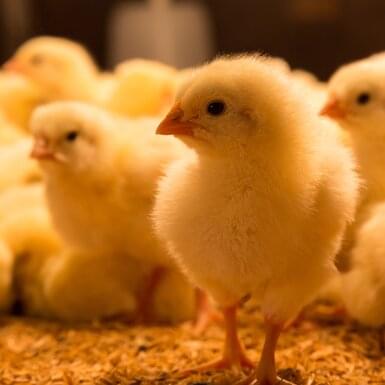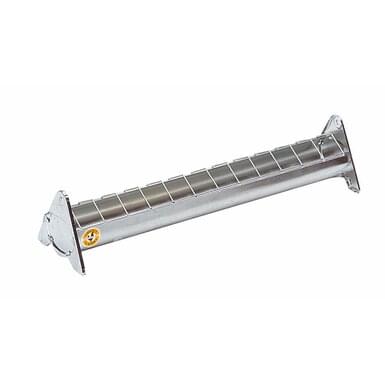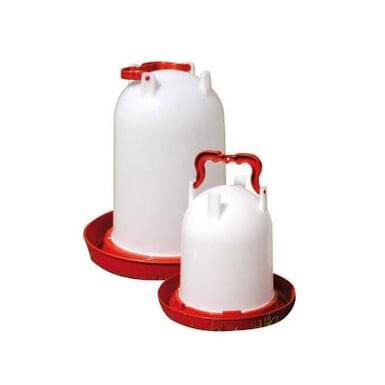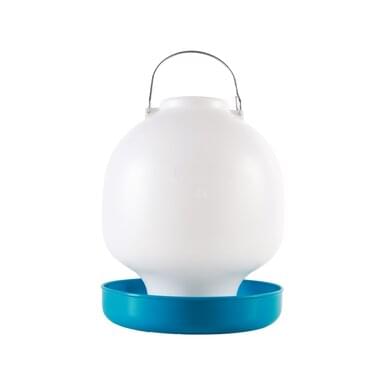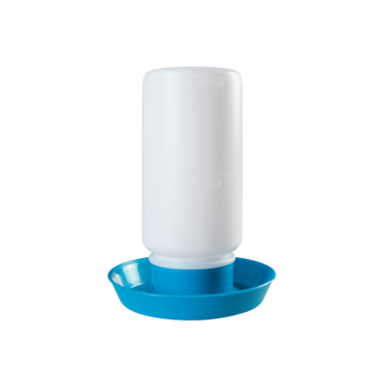Chick rearing
Here you will find everything for species-appropriate chick rearing from drinkers and feed troughs to warming plates.
Feeding trough for chicks | galvanized steel | with grid
- Galvanized steel
- Robust and weather resistant
- With movable grille
- Easy to clean
Plastic poultry drinker COMBO | with bayonet closure | red
- Hygienic & stable: With 4 clip-on feet for 7.5 cm floor clearance - protects against dirt and ensures a secure footing, even on uneven ground.
- Robust & easy to clean: Made from high quality plastic - durable and ideal for everyday use with poultry.
- Flexible use: Can be used upright or hanging thanks to the practical carrying handle - easy to fill thanks to the bayonet lock.
Plastic chicken drinker | blue
- high quality plastic
- UV-resistant
- can be used hanging or standing
- easy to clean
Plastic chicken drinker with bayonet cap | blue
- Bayonet screw cap
- high quality plastic
- UV-resistant
- can be used hanging or standing
horizontal heating plate for chicks CALEO 700 (30.5 x 23.0 cm) | including protective cover
- Cleanliness and hygiene thanks to the protective cover supplied
- Patented heating system
- Perfect fit
- Uncomplicated installation
Chick rearing - everything you need to know
When raising chicks, a distinction must be made between natural and artificial brooding. As a rule, the mother hen does most of the work and the poultry farmer only has to ensure a clean environment and supply of water and feed. In the case of an artificial brood, however, help is needed. There are a few things to consider so that the chicks have a problem-free development.
Raising chicks naturally - what needs to be considered?
The poultry farmer has relatively little work with natural rearing, the hen takes over the chick rearing and looks after the offspring herself. She gives the chicks warmth, protects them and shows them how to eat and drink water. The chicken keeper only has to provide optimal conditions, which include:
-
a dry coop
-
sufficient feed and fresh water
-
enough opportunities to run around
However, the mother hen does not look after the chicks forever. After about five weeks, the chicks become more independent and seek less and less protection from their mother. Finally, the family unit slowly breaks up and from the eighth week the hen separates from the chicks.
Artificial rearing of chicks - what needs to be considered?
In artificial rearing, the chicks grow up without their mother and the eggs are hatched in an incubator. They spend their first 24 hours there and are then transferred to a separate incubator where they continue to grow until they are reunited with the other chickens.
But what exactly is involved in artificial brooding?
Incubator
To begin with, you should consider what kind of incubator you want to use. You can find out exactly what you need to consider and which incubator is the right one read here. After the chicks have hatched, they remain in the incubator for another 24 hours without any problems.
What is important when rearing in the incubator?
After the first 24 hours, the chicks move to a separate incubator to stay there for another week until they move in with the other chickens. A sturdy cardboard box, a plastic box or a small animal cage is suitable as an incubator. Just make sure that there is enough space for the chicks.
Tips for setting up the incubator
-
Bedding
Do not use litter for the first few days, several layers of newspaper and kitchen paper will suffice for now. If litter is used, there is a risk that the chicks will eat large amounts of it and starve to death with a full stomach.
-
Heat source
Do not place the heat source, preferably a hot plate, in a corner of the incubator. The chicks will look for a comfortable place at the heat source. If they get too warm and the warming plate is in the corner, the chicks often don't know where to go.
-
Food
Make sure that the heat source is not near food or water. Both can be spoilt by the heat. Therefore, place the drinker and feed far enough away so that the chicks have free access to it.
Hygiene in the chick house - what should be observed?
General hygiene in the chicken house is of great importance. Particular attention should be paid to this during chick rearing. In the first few days the chicks are very susceptible to diseases. You should therefore always keep the floor clean and change it regularly to prevent the spread of germs. You should also clean the chick drinker and the feeder regularly.
What is the right temperature?
Chicken chicks cannot keep themselves warm in the beginning and therefore need an external heat source to prevent them from getting too cold and freezing to death after hatching. In nature, the mother hen takes over this task, but in artificial rearing, you need a heat plate or a heat lamp in the form of an infrared lamp.
What temperature is needed?
In the first few weeks, you should set a temperature between 32°C and 38°C. You can check the temperature at any time with the help of a thermometer. However, you can also tell if the chicks are too warm or too cold by their behaviour.
-
If the chicks are only on the outside of the heating plate or even lying sluggishly in the chick box, they are too warm and you should reduce the temperature.
-
If they all crowd under the warming plate or gather together, increase the temperature.
In the following weeks, when the feathers start to grow, lower the temperature steadily. You can remember to reduce the temperature by one degree every two days from day 5 onwards. However, you should never go below 18° C. After about six to eight weeks, the young chickens will have become accustomed to the lower temperatures and can go outside in a separate run with the other chickens.
After hatching: How should the chicks be fed?
Feed
After hatching, the chicks do not need solid food for the first 24 hours, as they feed on the yolk sac. After that, the chicks are offered pelleted chick starter feed or chick meal. You can also prepare your own food for the chicks.
Water
After hatching, the chicks are not able to drink water on their own. They lack the mother hen to show them how it works. You yourself can dip the chick's beak into the chick drinker again and again during the first few days. In this way, the chicks learn to drink on their own.
When are the chicks allowed to join the other hens?
As soon as the chicks have grown into pullets, the time has come to let them join the other hens. However, don't just put the youngsters in the hens' coop. Slowly getting them used to each other is very important here. When they get used to each other depends on the breed of chicken. With smaller, more peaceful chickens, this can happen after three to four weeks. Rougher breeds can take several months.
How exactly do you bring the chicks and the other chickens together?
-
Separate an extra area in your garden for the chicks so that they can get used to each other.
-
After a few days, open the fence a little so that the chicks can join the other chickens in the coop. Nevertheless, keep the food and water in the separate area.
-
From 10 days you can remove the separate fence and keep the birds together, as long as the chicks are not pecked too hard by the other chickens. If this is the case, keep the separate retreat.



